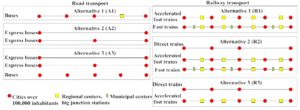Introduction and background
The transportation services between cities are usually carried by road or railway operators. In the situation that the routes are parallel, which means the passenger can choose one option from either road or railway transportation when planning the trip, the different operators are in a competitive situation for attracting passengers. However, if most of the passengers choose one operator, it will be considered a waste of resources for another option. Therefore, we need to examine the strategies offered by different operators and try to make optimal decisions when planning transportation strategies.
Game theory would help us formalize the mathematical model and analyze the transport system when the two “players” have conflicting objectives. In the following process, the model is formulated between the road operator and the railway operator.
Strategies for road and railway operators
The model is based on the railway and road network of the route Sofia-Burgas:
- There are 2 categories for road operators: bus and express buses, where express have less travel time and stop at fewer stations. It resulting in 3 strategies: A1 – Transportation by buses; A2 – By express buses; A3 – By buses and express buses.
- There are 3 categories for railway operators: direct train (only operates between big cities), accelerated fast train (serves large cities and important centers), and fast train (serves cities, centers, and additional municipal centers), examine 3 strategies: R1 – Transportation by accelerated fast trains and fast trains; R2 – By all three categories; R3 – By direct trains and fast trains.

Figure: Left – strategies by road operator; Right – strategies by railway operator
Game theory model
Game theory helps model the strategies for road and railway operators, formalizing two payoff matrices based on profit and number of passengers.
- Game theory model on profits – based on the profit of road operator. (determined by the multiplication of the ticket price and the number of passengers)


Figure: Game theory model on profits
- Game theory model on passengers – based on the passengers that were attracted by the road operator.


Figure: Game theory model on passengers
Analyzing Results
From the two payoff matrices, we can conclude similar results: For road transport, the optimal strategy is carriage by both buses and express buses, and the optimal choice for railway operators is to plan all three trains.
Conclusion
Considering the two models, the model based on passengers would be useful when planning routes, and the profit model may help with deciding optimal strategies and managing ticket prices. It can help plan railway and road strategies to improve resource utilization and make decisions in transportation management.
Reference
Svetla, S. APPLICATION OF GAME THEORY IN PLANNING PASSENGER RAIL AND ROAD TRANSPORT ON PARALLEL ROUTES. Technical University of Sofia, Bulgaria
2 replies on “Game Theory In Planning Transportation Strategies”
interesting read for sure! Its nice to see how the traffic models we looked at in class would apply to real data and augmented to prove useful in other situations such as ticket prices
The article discusses the use of game theory in analyzing strategies for road and railway operators, which I find quite amazing as it is not something that would come into my mind when thinking of game theory. The authors formulate a model using game theory to analyze the profitability and number of passengers for different transportation strategies, concluding that the optimal strategy for road operators is to offer both regular and express buses, while railway operators should offer all three types of trains. It is amazing to see that the things we learn in class can be used in the real world, in areas that would normally have no connection to CS.